Video Gamer is reader-supported. When you buy through links on our site, we may earn an affiliate commission. Prices subject to change. Learn more
Wondering how to win battles in Total War Pharaoh? Strategy games have plenty of diverse and complex mechanics, but as the name of Creative Assembly’s flagship franchise would suggest, Total War titles always come down to conflict in the end. So how do you win battles, and secure those pivotal turning points in your global conquests?
Here, we’re going to cover how to win battles in Total War Pharaoh by explaining how to control units on the battlefield in detail, and breaking down the major factors that affect your chances for victory. Mastering this alone won’t win you a campaign though. If you want an overview of how the game blends its features together, have a look at our Total War Pharaoh review. Alternatively if you just want some more tips and tricks to get to grips with the game, we’ve got you covered there too.
How to win a battle in Total War Pharaoh
Here are all the things you need to consider to help you win battles in Total War Pharaoh.
- Group your units
- Set up formations and stances
- Study the battlefield before beginning
- Be mindful of the weather
- Flank your enemies
- Use cover
- Be mindful of terrain and elevation
- Think about your army composition
- Choose your posture
- Be mindful of exhaustion and morale
- Use reinforcements
All of these factors can have a major effect on how battles play out, but proper mastery will allow you to defeat even numerically superior foes. Let’s break each one down in some more detail.
Grouping units
One of the most basic mechanics is unit grouping, and it can be key to efficient and effective unit control on a battlefield. To group units, select the units you want. You can use shift+click to mass select across your unit menu bar at the bottom of the screen, or ctrl+click to select multiple different units spread out across the unit menu bar. Then just click the icon on the top of the bar that looks like three upward-pointing glaives.
Grouping units allows you to compartmentalise your forces into more manageable subdivisions. This way, even if your army is spread out across vast distances at the beginning of a fight, you can coordinate different segments more effectively, reducing the amount of micromanagement necessary. This can be key when trying to win battles in Total War Pharaoh that involve multiple adversaries or larger armies.
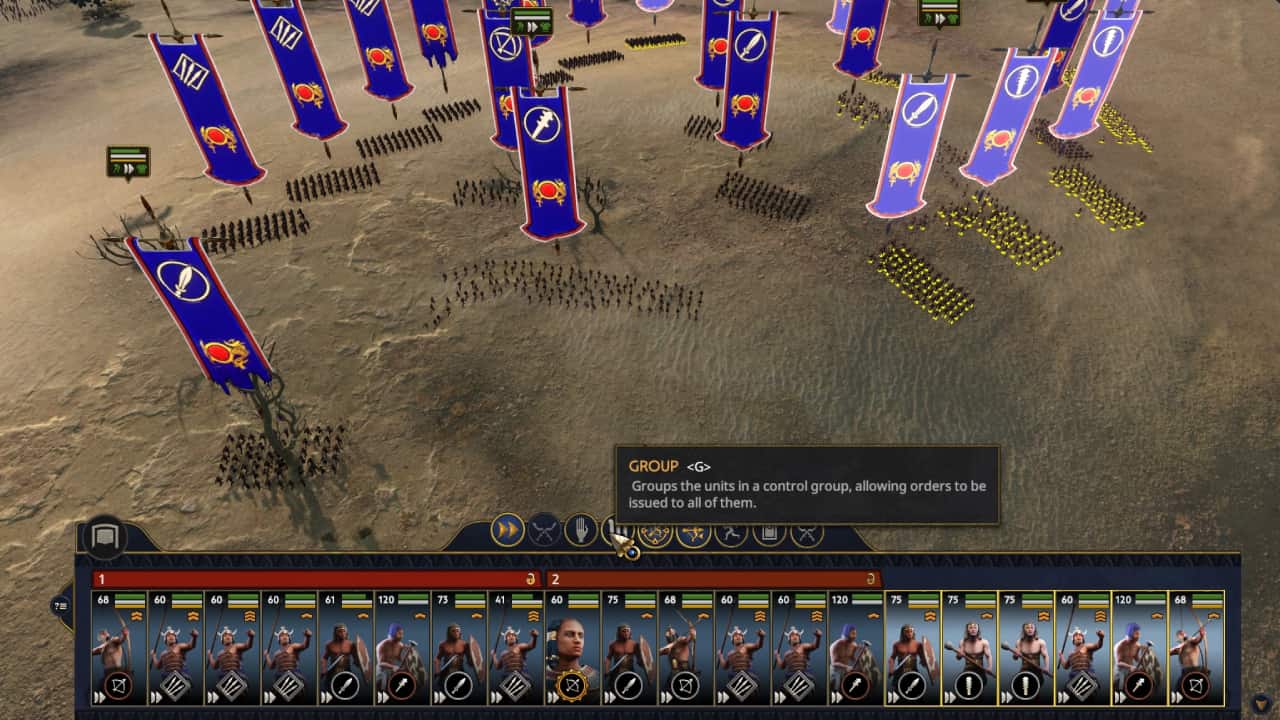
Setting up formations and stances
Another two key controls for units are formations and stances. These can be useful in the moments before two rival sides clash, allowing you to ensure your lines are set correctly and your units basic orders are in place.
Formations are controlled by the two crossed swords at the end of the unit menu bar. You can set up units to hold either a ranged or melee front. Depending on where the enemy is relative to you, the chances of a flank attack, and how you plan a unit or group to position themselves, both formations can find plenty of use.
As well as formations, you can change a unit’s stance with the shield icon. If you want a unit to hold a position and not pursue routed enemies, this is the selection to do it through. You’ll find this particularly useful when you’re fighting from a defensive posture.
It’s also worth noting the bow symbol just next to it on range units. This controls whether or not ranged units will attempt to keep a distance from enemies, falling back if they get to close. Toggle it if you want to move them deeper into a battle.
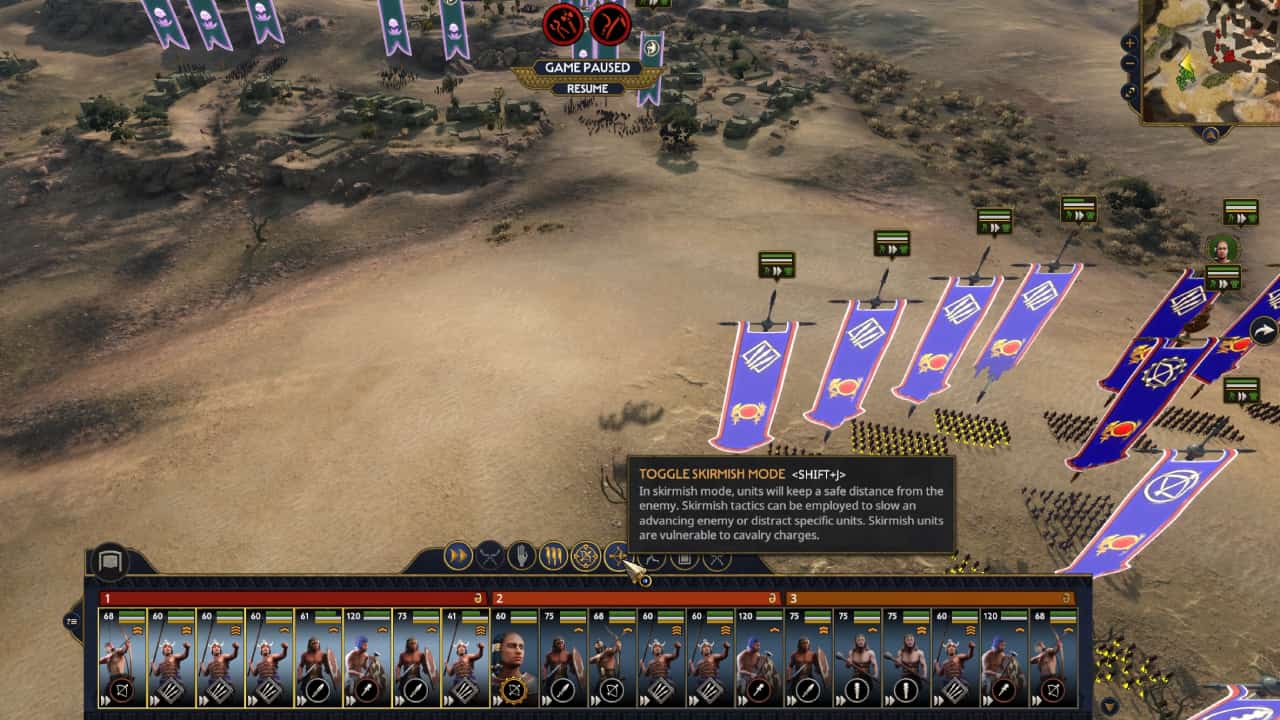
Study the battlefield before beginning
At the start of every battle you’ll have your deployment phase. Time is paused here, and units can’t move, but can be moved around as you choose how to deploy them. Select a unit and click on any terrain within your yellow highlighted zone to move them to that starting position instead. You can also fine-tune their starting formation and the direction they’re facing by holding click and dragging.
While you’re doing this, be sure to take a look at the battlefield as you set up for the conflict ahead. Study the routes, elevation, cover, bottlenecks, and natural defences, and carefully consider the best route forward. If you’re able to gauge the enemy positions before a fight, careful study may highlight unique opportunities to exploit key weaknesses in their approaches.
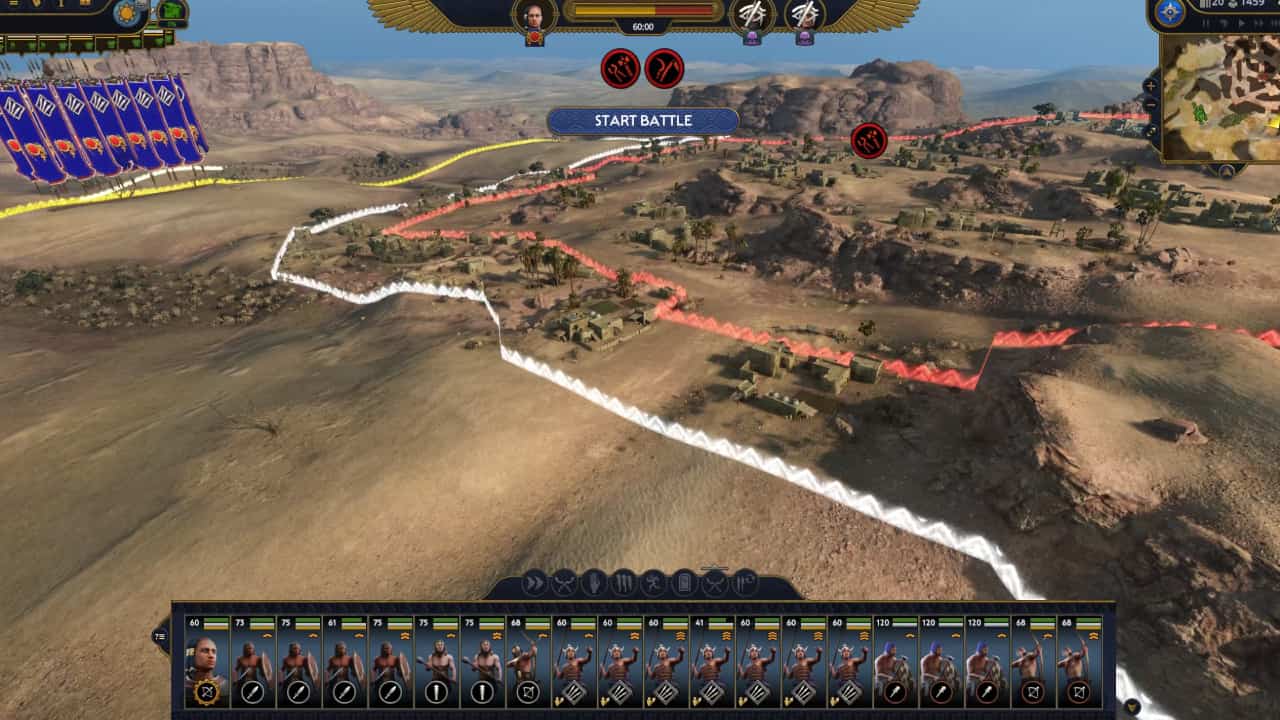
Be mindful of the weather
Weather can have an enormous impact on a battle, so it’s important to be mindful of it. There are several types of weather you can encounter regularly, including:
- Sandstorms – These will inflict major debuffs on unit movement, range, line of sight, and attack.
- Thunderstorms – These will cripple the range, rate of fire and attack of ranged units.
- Sweltering heat – This weather will rapidly increase the exhaustion of all fighting units.
- Normal weather – There are no buffs or debuffs of any kind in this weather.
When you first enter a battle, you’ll have two opportunities to wait before engaging. If the current weather is severe, this might be a good idea, but beware that the forecast weather can and will come into play should the battle drag on for a significant amount of time.
Also think carefully about how certain weather could work to your advantage. If you’re defending in a siege, sweltering heat could be a good way to wear your enemies down. Or perhaps you’re storming a fortified position – in which case, a melee-heavy force might be at an advantage attacking bows and slingshots during a thunderstorm.
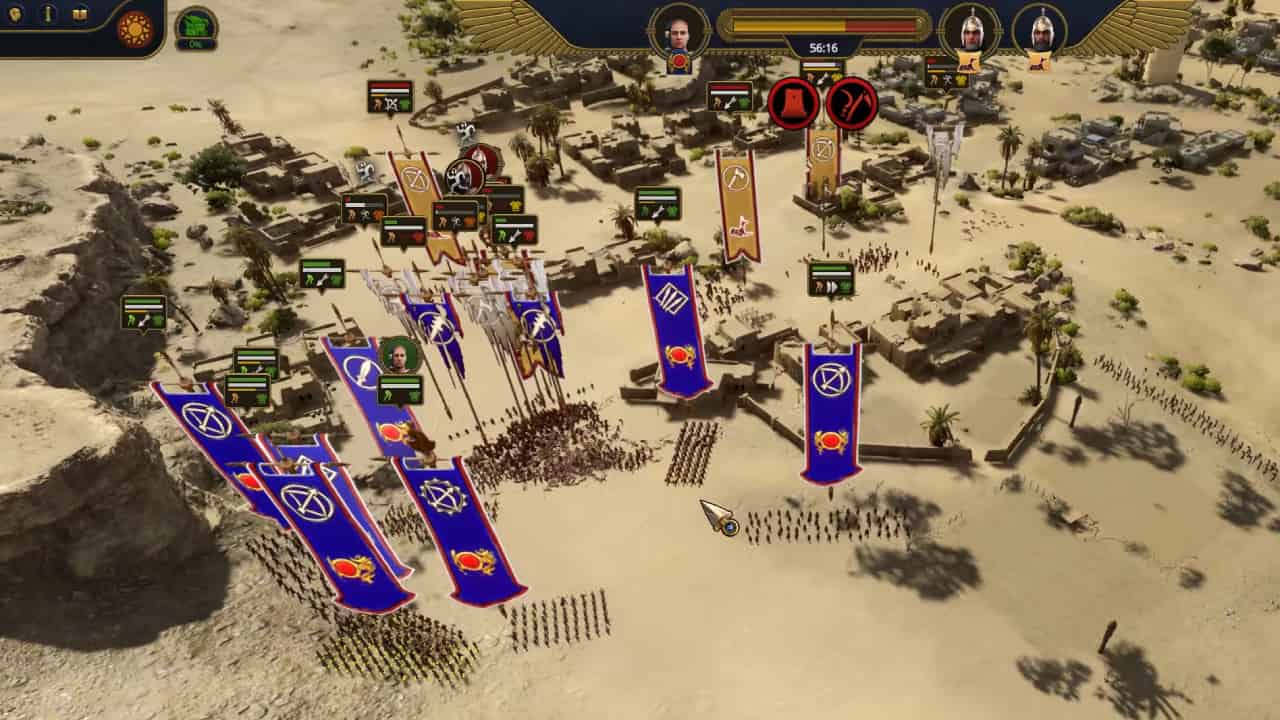
Flanking your enemies
When controlling units, one move stands above the rest as a game-changer: flanking. Successful flanks can turn the tide of an engagement, putting an attacking force on the defensive as they have to combat from multiple sides to avoid total encirclement. Try to make prolific use of it if you want to win battles in Total War Pharaoh.
You can simply right click a unit on terrain to move them to that area, though this isn’t as accurate when moving large numbers at once. Micromanagement can pay off here though, allowing you to move in quickly and position units beside or behind an enemy. A good setup relative to your enemy before a battle is also a fantastic way to hit their flanks and cripple their armies.
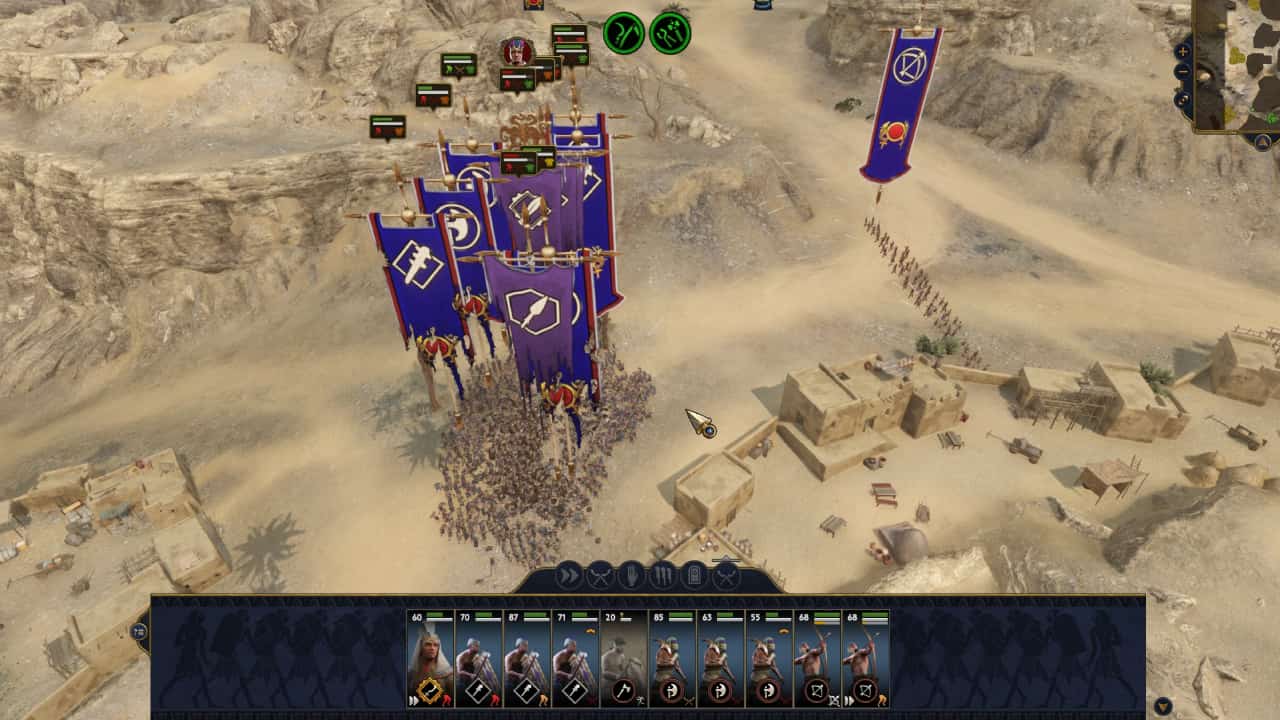
Using cover
Cover is fairly prevalent in most battlefields, and essential to maintaining a balance between defence and offence.
Strictly speaking, there are a few different kinds of cover to consider. Large terrain features and walls are the most comprehensive, providing total protection from range attacks due to their size. Smaller cover, like houses, dunes, or smaller rock formations can also provide some cover. Ranged units can still fire over this to hit targets, but typically hit less often without a clear line of sight.
Finally, there’s cover that isn’t technically cover, like forests. These don’t protect units from ranged attacks, but units hidden in this sort of cover will be invisible to nearby adversaries, making it extremely useful for setting up ambushes and flanking manoeuvres.
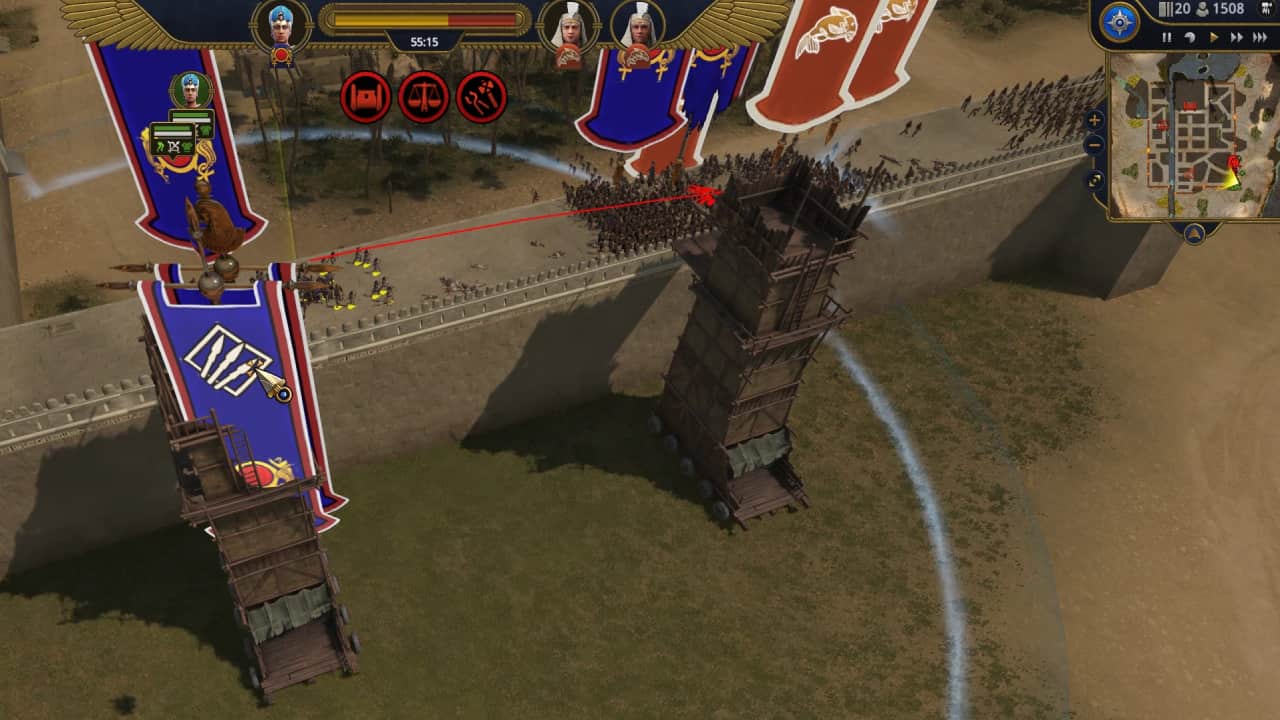
Keeping terrain and elevation in mind
Different types of terrain will also have effects on your troops. Units will move much slower in water or mud for example, with heavier units like cavalry suffering the greatest debuffs. Mud especially also debuffs defence and offence. If possible, luring enemies onto unfavourable terrain can be a great way to win an advantage. If not, try to avoid the worst types of terrain where you can, or at least move through them safely when no enemies are nearby enough to intercept.
Going hand-in-hand with terrain is elevation. Units on elevation are far stronger, especially ranged units, who can hit more accurately. Conversely, you’ll be at a disadvantage if fighting uphill. Always try to take the high ground when and where possible.
These are both key features to take observation of when you’re preparing before a battle. If you’re looking to play Total War Pharaoh multiplayer, battles against other people can often be decided by how well you can use the battlefield to your advantage.
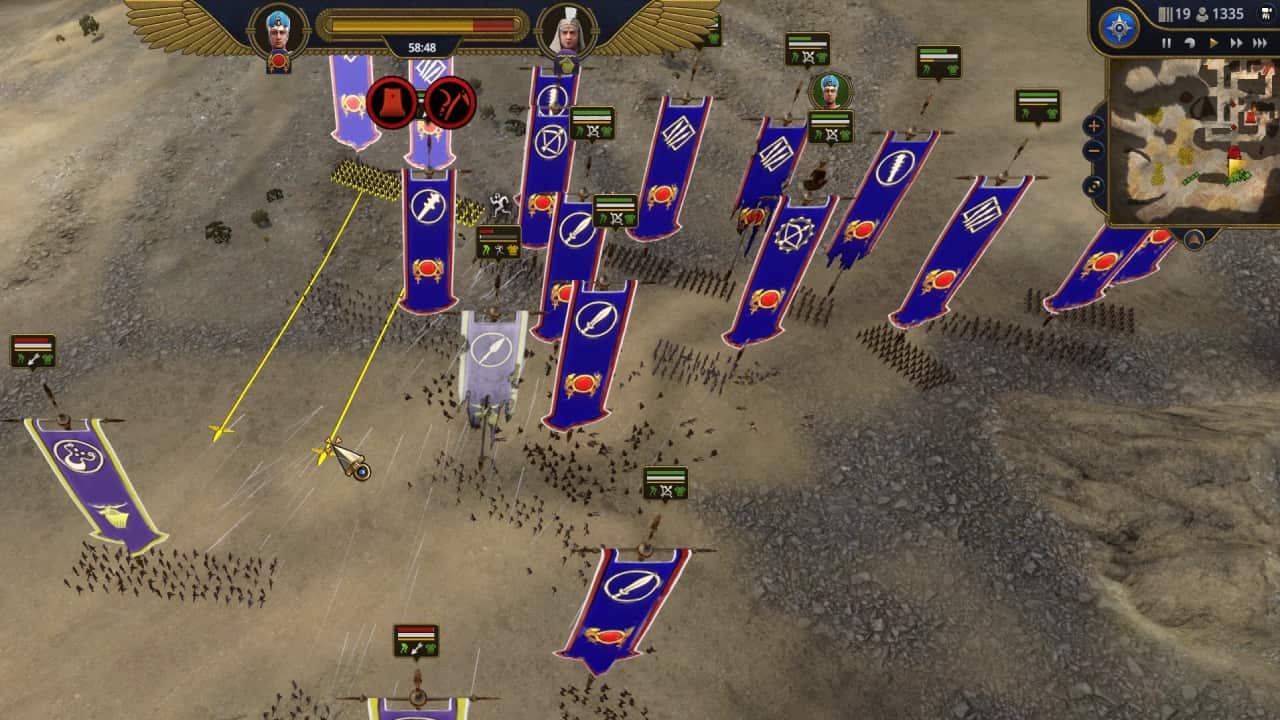
Thinking about army composition
Before you go into a battle, take some time to think about how you’re constructing your armies, and which units you are choosing. Your main unit types to choose from are:
- Melee. This includes spearmen, swordsmen, and clubmen. They’re your main infantry, and provide protection to your other units, as well as great offensive capabilities.
- Ranged. Archers, Javelin throwers and slingshotters can use missiles (projectiles), to harm enemy units from range, and serve as essential supporting fire for your melee components.
- Cavalry. Mounted units can be both ranged and melee, and offer heavy-duty, lightning fast options for attacking flanks or shattering enemy formations. Be wary of javelins and spearmen though, who can cut through horseback units with ease.
Ideally, striving for a balanced mixture is the best way to ensure your army is versatile, but if you’re anticipating specific situations, it might be worth specialising with more units of certain types. Don’t forget that developing buildings and recruitment stations in your settlements can give you access to stronger units as well, such as veteran and elite variations. These more powerful variants provide a huge bonus over your enemies, but be careful of their expense.
The more units you have, the greater the cost. Not only in initial purchasing, but also in upkeep. All units will cost food and bronze to maintain, especially elite units. If you’re struggling to find a balance and want some pointers on how to get resources, we’ve got you covered.
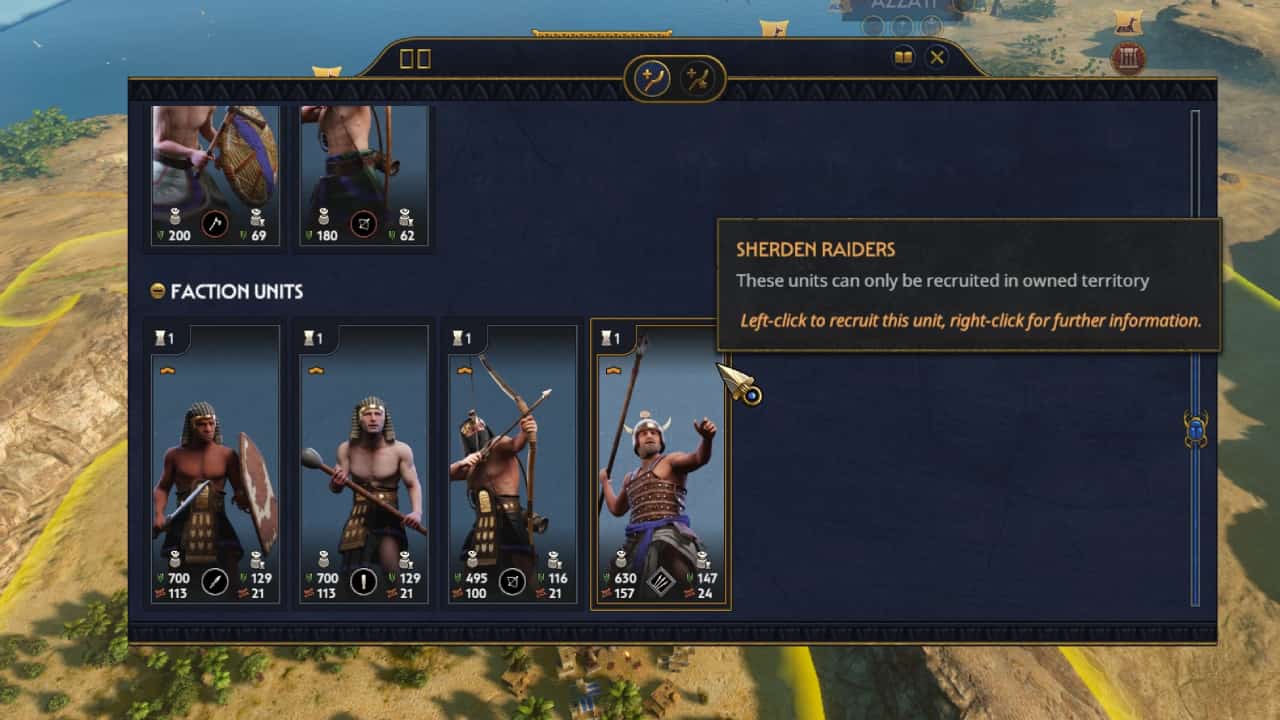
Choosing your posture
Ultimately, you can approach a battle in one of two ways: you can go on the attack, or stay on the defence. You may not always have a choice in this – obviously if you’re being attacked then a defensive posture is usually necessary to begin with.
Sometimes though you’ll be able to decide which posture best suits a given situation. Take stock of your surroundings, including your terrain, elevation, weather forecast, and positioning, and decide carefully how to precede. Moving from one posture to another might be a better way to let the battle flow, luring an enemy into your lines and then launching a counterattack once you find a weak point.
Staying mindful of exhaustion and morale
The last two big features we haven’t yet touched on are exhaustion and morale. These two are intertwined, and arguably are the most important features of all.
Exhaustion will build up over the course of a battle. Units that move around and fight will experience rising exhaustion, and this can be accelerated by factors like terrain or weather, such as sweltering heat. The more exhausted they become, the less effective they’ll become, and the quicker their morale will drain. The best ways to combat exhaustion are to cycle units out of the front lines and let them rest for a while, ensure they come into battle fresh and ready, and to end battles as quickly as possible.
Morale is your victory condition within a fight. When a fight begins, the bar at the top will indicate the morale of both sides, and the relative balance. The course of the battle will then affect morale, and whoever loses it all first loses the battle. A lot of factors will affect this. As mentioned, exhaustion is a big one, but so is the weather. Casualties are the most obvious effect, and high losses in a unit will eventually cause them to route, temporarily fleeing from battle until they gain momentary recovery once clear of combat. Watch out especially for your leaders in battle. If their unit routes, or worse, is destroyed, then your side’s morale will take a massive hit.
Ultimately, breaking as many enemy formations and routing as many units as you can quickly is the surest path to victory.
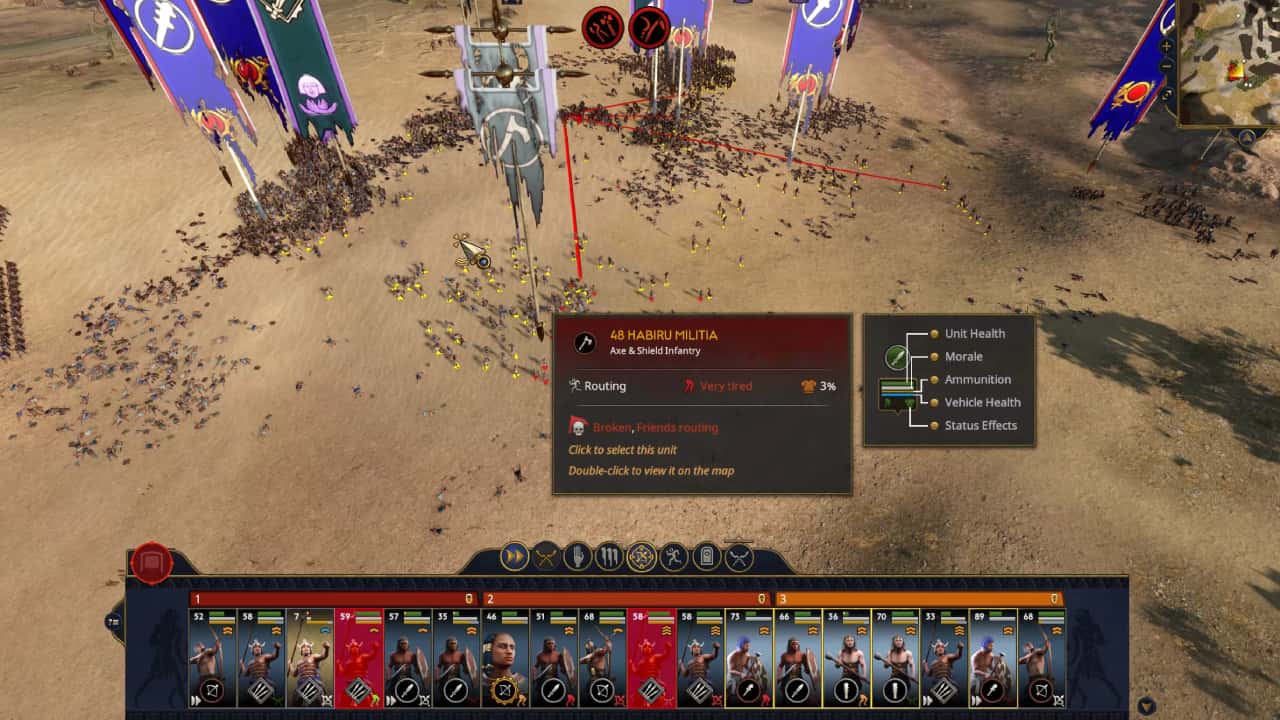
Using reinforcements
This is a game-changing feature, but it’s one you’ll need to set up before a battle begins. If you have an army spare, move them into position near your battle site, as long as they are adjacent to the glowing circle that surrounds an enemy unit when highlighted, they can join in with any battle which then initiates. In sieges or ambushes, the presence of a second army gives you an overwhelming advantage, and can quickly tip the scales. While you can’t decide where they’ll spawn in, it tends to be somewhere inconvenient for the enemy, allowing for easy flanks or split attention.
Should the opportunity present itself, try to make use of reinforcements as often as you can to win battles in Total War Pharaoh.
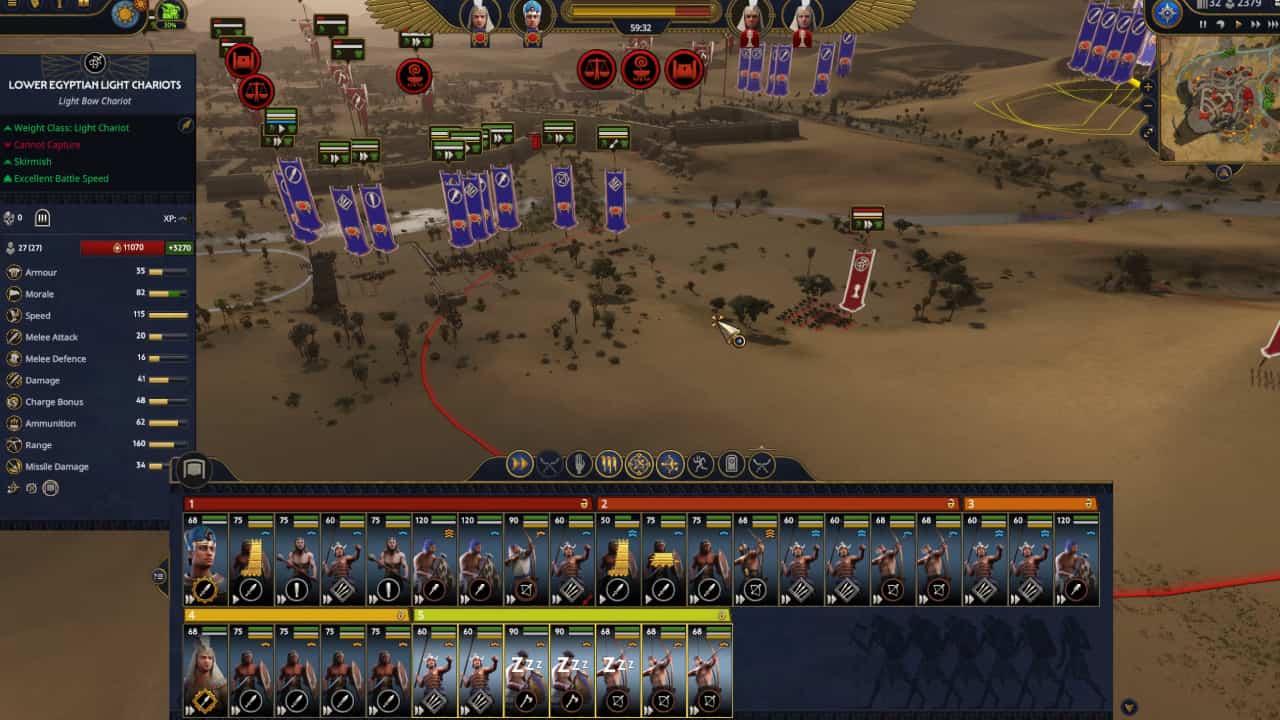
Should you use auto-battle in Total War Pharaoh?
When you prepare for a battle, you’ve got three options open to you. One is to retreat, which will call off the battle. Another is to enter the battle, which obviously leads you into combat. The third option though is to use auto-battle. This system will weigh up the strength of your army against your opponents, and then determine the victor and casualties automatically on selection. It’s a good way to end a battle quickly if you’re finding it a bit tedious.
Did you know?
When an army comes under attack, it can only retreat once if it’s not that leaders turn, before it will be forced into an engagement.
We would recommend using the auto-battle in any situation where you have a clear numerical advantage. In situations where numbers on either side are close, you’re liable to take much higher casualties or even lose, whereas a manual fight may result in a different outcome.
That covers all our advice on how to win battles in Total War Pharaoh. The more of this you’re able to put into practice, the better. But there’s a lot more to learn if you want to win a campaign. If you’re not yet familiar with how to start a campaign, including the extensive setup options, or haven’t got all the information on core mechanics like the Pillars of Civilisation and how to beat the Sea Peoples, we can help you out.
Is auto-battle balanced in Total War Pharaoh?
Auto-battle is fairly balanced in Total War Pharaoh, but struggles to count for all factors when armies are comparable in size.
How do you rout enemies in Total War Pharaoh?
To route enemies, inflict morale damage on them. The best way to do this is by killing units.

